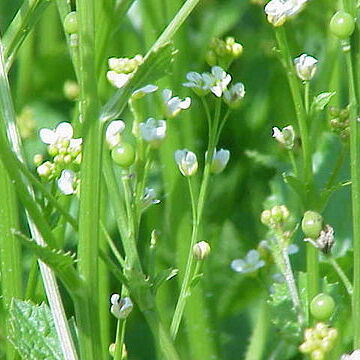Annual herb.. Stems erect, furrowed, (20–)40–150 cm. high, branched in upper parts, basally densely hispid, upwards with more scattered hairs.. Leaves densely to moderately hairy on both surfaces; lower and median leaves petiolate, lyrate-pinnate, 4–13 cm. long; terminal lobe large, ovate to acutely ovate (outside E. Africa also reniform), truncate to cordate (rarely cuneate); lateral lobes much smaller (sometimes reduced), in 1–2 pairs, elliptic, usually 0.5–2 cm. long; upper leaves sessile or shortly petiolate, simple, acutely ovate to rhombic; margins serrate to biserrate.. Racemes with numerous small white flowers, in fruit lax, usually with several side branches, sparsely hairy or glabrous, up to 40 cm. long; pedicels ascending to erect, 4–9 mm. long.. Sepals green with narrow margins, elliptic, 1.5–3 mm. long.. Petals white, spathulate to almost clawed, with limb expanded, 2.5–5.8 mm. long, and ± half as broad.. Stamens 2–3 mm. long; anthers 0.7–0.8 mm.; filaments linear, median ones denticulate.. Upper segment of ovary ellipsoid, broader than and 3–4 times as long as the lower.. Nutlet spherical, smooth, 2.2–5 mm. in diameter, with a smooth yellow-brown seed; lower fruit segment and gynophore indistinctly demarcated, together 0.7–1.5 mm. long.
More
Slender annual herbs up to 1 m tall but usually much smaller; young parts and especially near the base densely hispid, glabrescent. Lower leaves lyrate-pinnatisect with 1-2 pairs of very small lateral lobes and a large, ovate-oblong to reniform-orbicular, terminal lobe. Racemes dense in flower, lax in fruit. Flowers small, white, the petals 3-4 mm long. Siliculae small, the lower segment about 1 mm long, cylindrical; the upper segment 3-4.5 mm in diameter, globose, 8-nerved, reticulate.
A cabbage family herb. It is a slender erect annual plant. It has bristles and grows 1 m tall. The lower leaves are large and kidney shaped or rounded with teeth around the edge. The flowers are white and 3-4 mm across. The petals can be tinged with purple at the base. The flowers are in a large branched panicle. The pod is 2-4 mm long. It has one seed.

